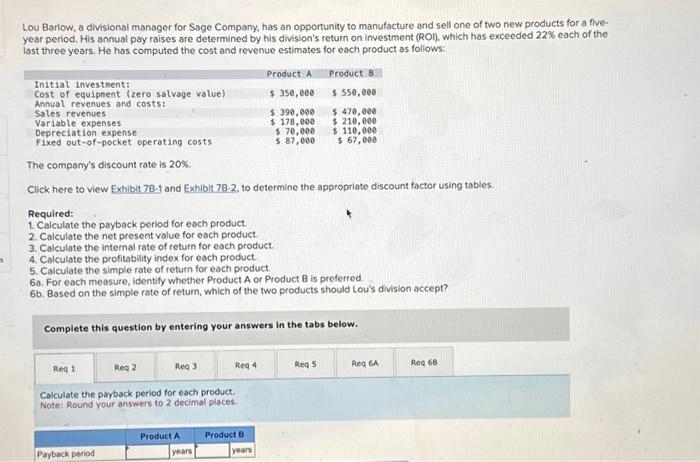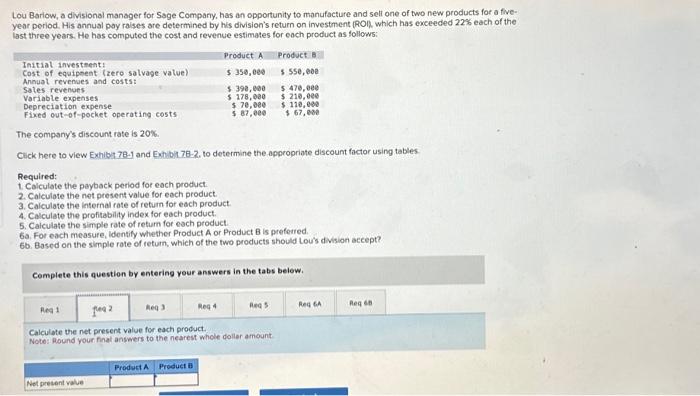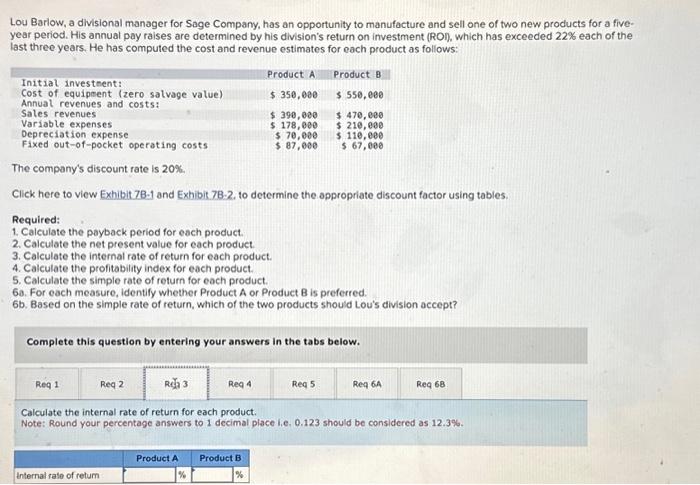

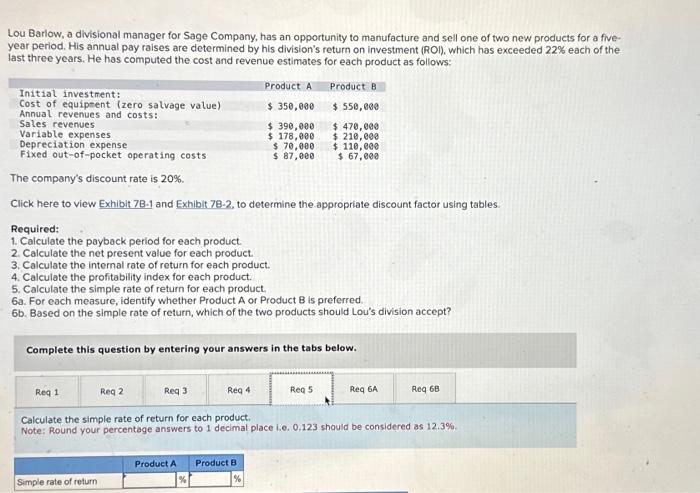
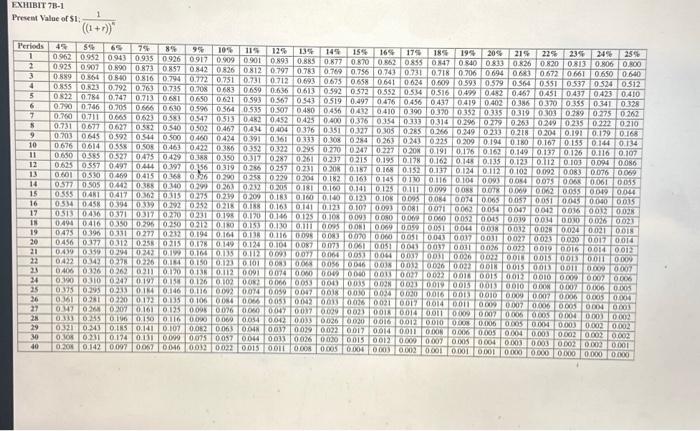
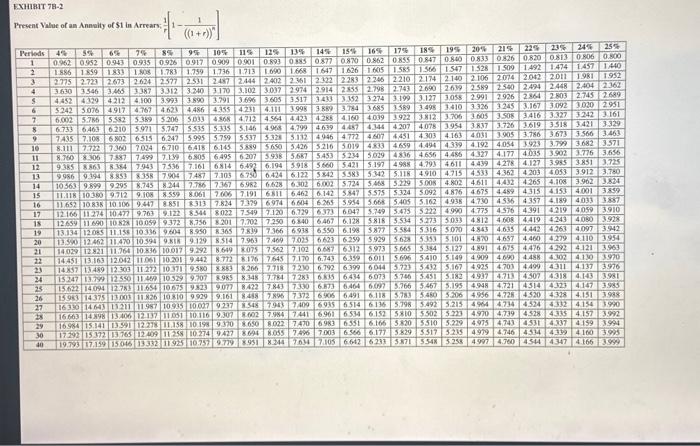
EXHIBIT 7B-1 Prosed Value of 51: ((1+r))51 EXHIIT 78-2 Precent Value of an Annality of $1 in Arrears; r1[1((1+r))n1] Lou Barlow, a divisional manager for Sage Company, has an opportunity to manufacture and sell one of two new products for a fiveyear period. His annual pay raises are determined by his division's return on investment (ROI), which has exceeded 22% each of the last three years. He has computed the cost and revenue estimates for each product as follows: The company's discount rate is 20%. Click here to view Exhibit 781 and Exhibit 78-2, to determine the appropriate discount factor using tables. Required: 1. Calculate the payback period for each product. 2. Calculate the net present value for each product. 3. Calculate the internal rate of return for each product. 4. Calculate the profitability index for each product. 5. Calculate the simple rate of return for each product. 6a. For each measure, identify whether Product A or Product B is preferred. 6b. Based on the simple rate of return, which of the two products should Lou's division accept? Complete this question by entering your answers in the tabs below. Calculate the simple rate of return for each product. Calculate the simple rate of return for each product. Note: Round your percentage answers to 1 decimal place i.e. 0.123 should be considered as 12.3%. Lou Bariow, a divisional manager for Sage Compary, has an opportunity to manufacture and selt one of two new products for a flveyear period. His annusl pay ralses are determined by his division's return on imvestment (RO) which has exceeded 22% each of the last three years. He has computed the cost and revenue estimates for each product as follows: The company's discount rate is 20%. Cick here to view Exhibat 78-1 and Exhibi: 78-2, to determine the appropriate discount factor using tables. Required: 1. Colculate the payback period for each product. 2. Calculate the not present value for each product. 3. Caiculate the internal rate of return for each product. 4. Calculate the profitability index for each product. 5. Calculate the simple rate of retum for each product. 6a. For each measure, identify whether Product A or Product B is preferred. 6b. Based on the simple rate of return, which of the fwo products should Lou's division accept? Complete this question by entering your answers in the tabs below. Calculate the net present value for each product. Calculate une net present value for each probuct. Note: Round your hnal answers to the nearest whele doller amount Lou Barlow, a divisional manager for Sage Compary, has an opportunity to manufacture and sell one of two new products for a fiveyear period. His annual pay raises are determined by his division's return on investment (RO), which has exceoded 22% each of the last three years. He has computed the cost and revenue estimates for each product as follows: The company's discount rate is 20%. Click here to view Exhibit 781 and Exhibit 78-2, to determine the appropriate discount factor using tables. Required: 1. Calculate the poyback period for each product. 2. Calculate the net present value for each product. 3. Calculate the internal rate of return for each product. 4. Calculate the profitability index for each product. 5. Calculate the simple rate of return for each product. 6a. For each measure, identify whether Product A or Product B is preferred. 6b. Based on the simple rate of return, which of the two products should Lou's division accept? Complete this question by entering your answers in the tabs below. Calculate the profitability index for each product. Note: Round your answers to 2 decimal places. Lou Barlow, a divisional manager for Sage Company, has an opportunity to manufacture and sell one of two new products for a fiveyear period. His annual pay raises are determined by his division's return on investment (RO), which has exceeded 22% each of the last three years. He has computed the cost and revenue estimates for each product as follows: The company's discount rate is 20%. Click here to view Exhibit 781 and Exhibit 78-2, to determine the oppropriate discount factor using tables. Required: 1. Calculate the payback period for each product. 2. Calculate the net present value for each product. 3. Calculate the internal rate of return for each product. 4. Calculate the profitability index for each product. 5. Calculate the simple rate of return for each product. 6a. For each measure, identify whether Product A or Product B is preferred. 6b. Based on the simple rate of return, which of the two products should Lou's division accept? Complete this question by entering your answers in the tabs below. Calculate the internal rate of return for each product. Note: Round your percentage answers to 1 decimal place i.e. 0.123 should be considered as 12.3%. Lou Bariow, a divisional manager for Sage Company, has an opportunity to manufacture and sell one of two new products for a flve: year period. His annual pay raises are determined by his division's return on investment (ROI), which has exceeded 22% each of the lost three years. He has computed the cost and revenue estimates for each product as follows: The company's discount rate is 20%. Click here to view Exhibit 781 and Exhibit 782, to determine the appropriate discount factor using tables. Required: 1. Calculate the payback period for each product. 2. Calculate the net present value for each product. 3. Calculate the internal rate of return for each product. 4. Calculate the profitability index for each product. 5. Calculate the simple rate of return for each product. 6a. For each measure, identify whether Product A or Product B is preferred. 6 b. Based on the simple rate of return, which of the two products should Lou's division accept? Complete this question by entering your answers in the tabs below. Calculate the payback period for each product. Note: Round your answers to 2 decimal places
